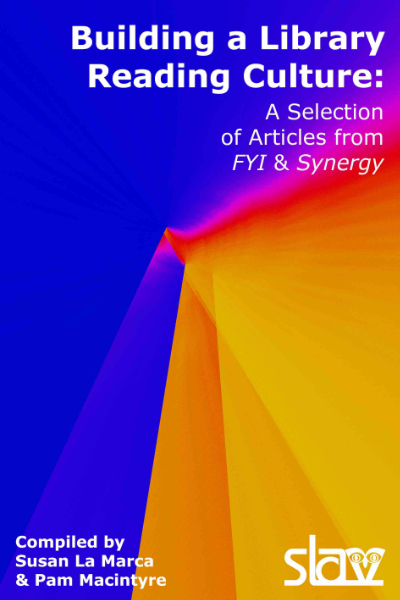Issue 118
TERM 3 2021
Building a reading culture: A selection of articles from FYI and Synergy
Building a reading culture: a selection of articles from FYI & Synergy compiled by Susan La Marca and Pam Macintyre School Library Association of Victoria, 2021. ISBN 9780909978044 (e-book) 291pp.

Highly recommended. When finishing this wonderful collection of articles published in FYI and Synergy, I found myself enthused about the importance of promoting reading in schools and really enjoyed the historical overview given by the articles, ranging from some written in 2000 to those written in 2020. The book is divided into three sections; Research and Reflections, Practice, and Organisations. The Introduction by Dr Kasey, Senior Lecturer in the School of Information Studies at Charles Sturt University, summarises the content of the book in a masterly manner and gives an excellent overview of what the reader will find in each section.
Readers coming to Building a reading culture could examine all the articles or, as many may do, can select articles that are pertinent to them at the time of need. What stood out for me and challenged my ideas in the Research and Reflections section was ‘Current and historical perspectives on Australian teenagers’ reading practices and preferences’ by Dr Jacqueline Manuel and Don Carter (2016) which showed the genres that teens most liked to read and emphasised the importance of the English teacher on selection. This was echoed in ‘Teen reading in the digital era’ by Leonie Rutherford (2017) showing the top genres as fantasy, contemporary realistic, science fiction, autobiography and biography and action/adventure. In ‘Myths about children, teenagers, books and reading’ by Margaret Merga, the myth that all reading is equally beneficial made me think and sent me off to Merga’s website (researchgate.net/profile/Margaret-Merga-2) where I found many useful articles. ‘Anatomy of a dissertation: What Emily discovered about gendered literacy’ by Carol A. Gordon (2015) also emphasised the importance of free voluntary reading but advised not to label books according to boy or girl in reading lists.
SLAV has chosen to make the Practice section of the book into a print and e-book (ISBN: 9780909978037), which will be perfect for those who are mainly interested in improving their practice. In this section it was hard for me to pick articles that stood out as all were very helpful. ‘Windows and mirrors: visibility and representation in Australian LGBTQIA+ YA fiction’ by Nell Day (2019) gives ideas and book lists to grow a more diverse collection. ‘Banned books week’ by Sue Bursztynski was inspirational: with a limited budget, students filmed readings from banned or challenged books, engendering much enthusiasm. Practitioners would find many gems among the advice ranging from building a whole-school reading culture and the importance of using data in a reading program, boys’ reading and book clubs, setting up a collection based on genres with the help of students, the use of e-books and print collections, to guidance on starting a literary festival.
In the Organisations section, more ideas to inform can be found. The importance of the Indigenous Literacy Foundation is described, and Victorians will learn about the Languages and Multicultural Education Resource Centre, while some school libraries may wish to take the opportunity to join the Stella Prize School’s Program or the ISLM bookmark exchange project.
In the Organisations section, more ideas to inform can be found. The importance of the Indigenous Literacy Foundation is described, and Victorians will learn about the Languages and Multicultural Education Resource Centre, while some school libraries may wish to take the opportunity to join the Stella Prize School’s Program or the ISLM bookmark exchange project.
Themes: Reading, Research, Reading culture, School libraries.
ReadPlus and LinksPlus
https://www.readplus.com.au and https://www.weblinksresearch.com